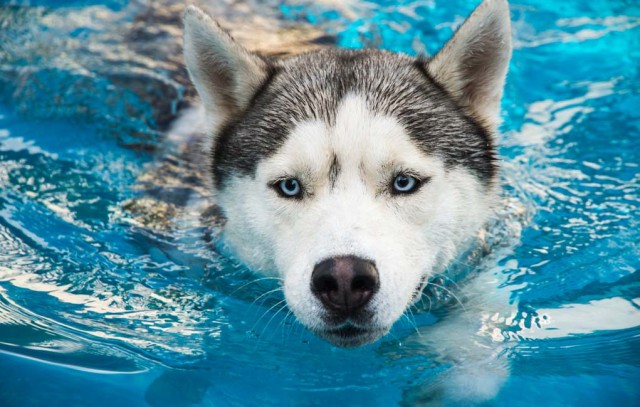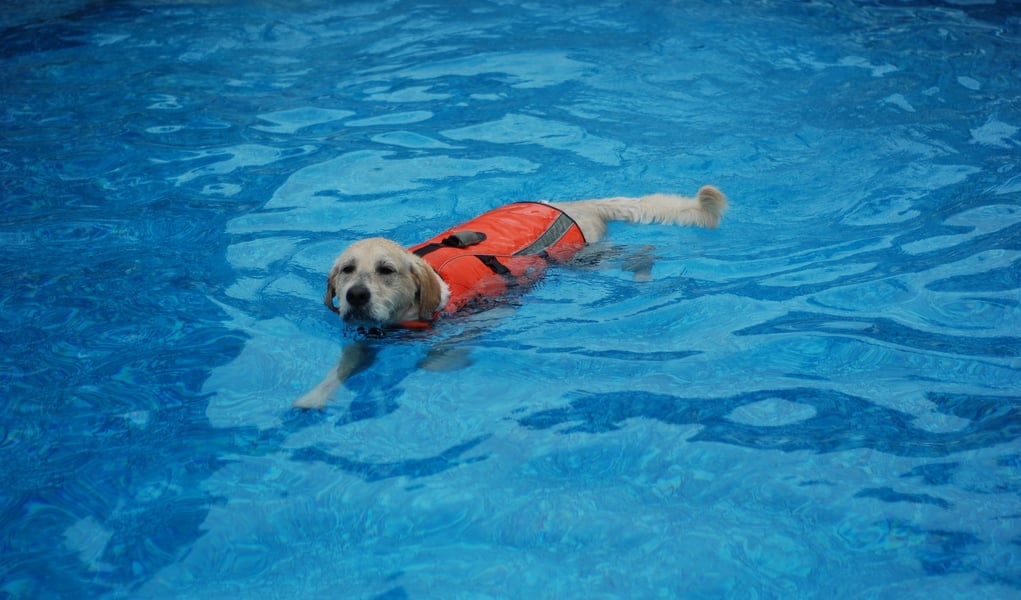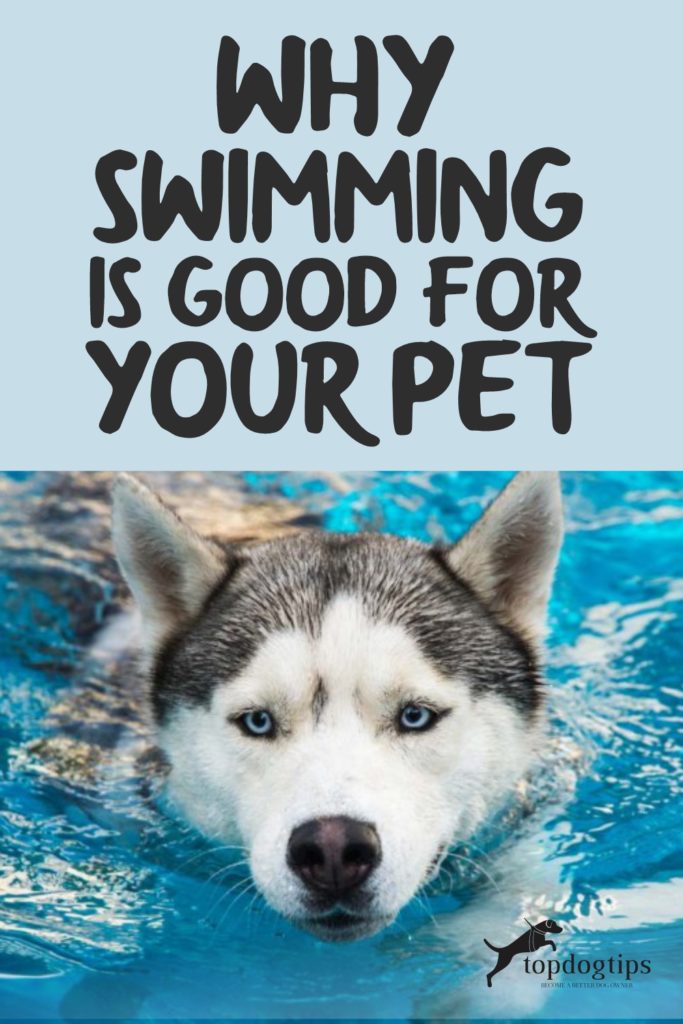
Table of Contents
It’s that time of year again, to use the old cliché.
Summer is still here, and it's pretty warm in most parts of the country, whether we’re fans of the heat or not.
It's time for people to start booking their schedules with summertime activities to fill their days.
One of these activities, which is both popular and fun, is swimming — though most people generally don’t think to take their dog into the pool with them.
Having a splash in the pool with your pet is a great activity for both of you.
Swimming is an excellent form of exercise that is good for your muscles, joints, and cardiac system and fosters your overall health and well-being.
If that's not enough of a reason to get you in the pool with your pooch, swimming together is also a great bonding experience that will strengthen your relationship.
Like any other exercise you do with your dog, safety needs to be a priority when swimming.
There are definitely some great benefits to hopping in the pool with your pup, but dogs can be unpredictable, and that's the last thing you want in the water.
This article will give you some tips and tricks to help you enjoy swimming with your pet while being safe at the same time.
And if your pup doesn't know how to swim, we'll give you some pointers on how to teach him.
RELATED: The 5 Best Dog Pools for Your Fido
Dogs in Pools: Why Swimming is Good for Your Pet
Your dog’s health can be vastly improved by swimming.
One minute of swimming equates to four minutes of running.
The resistance of the water means that a person, or a dog, in this case, has to work his muscles extra strenuously to push through it.
If your pool is heated, that’s even better because that will make it easier for your dog to warm up.
No one likes freezing pool water, and your dog, furry though he may be, is no exception.
Also, warm water temperature entices dogs that may not be too sure about the water.
As his physical fitness improves, your dog can swim for longer bursts at a time.
If you have an elderly dog or one that has issues with exercise (legitimate ones, not just him not feeling like exercising), the pool serves as a way for him to achieve recovery, especially for dogs that have orthopedic problems.
If, for example, your pet has had surgery, there will eventually be a need for the area to be re-strengthened.
After an appropriate amount of time has passed and the dog can engage in mild physical activity again, the pool provides a source of exercise for him that is weightless.
Exercising in the pool aids recovery by strengthening joints, facilitating circulation, and helping fortify muscles.
Alternatives to swimming, such as running or walking, can cause your dog to risk additional injury as his paws consistently pound into the ground.
Weightless exercise in the pool is a viable and recommendable alternative.
Even if your dog is overweight, swimming in the pool is a good way for him to try to lose some weight without overworking already-stressed joints and muscles.
Being overweight strains the body of any creature, dogs included, and swimming burns calories without causing any additional problems.
Swimming in the pool can even serve as an emotional therapy in some cases.
For example, working dogs and police dogs are taken swimming for playtime to improve their mental state and relieve any stress.
RELATED: A Basic Guide to Hiking with Dogs

Teaching Your Dog to Swim
Dogs aren’t necessarily innately going to jump in the water like the canine version of Michael Phelps.
So when you take your dog into the pool, observe him.
If he seems unsure of what to do, guide him around the pool encouragingly until he gets the hang of the doggy paddle.
It shouldn’t take too long.
If your dog fears the water, you'll have a little more work to do.
Dogs will do almost anything for a dog treat; use that to your advantage.
Start with a small amount of water – a few inches in a kiddie pool would be a great start.
Praise your dog and give him treats for staying in the water.
Keep working your way up until he will comfortably submerge himself in water.
Then you're ready for the pool!
REMEMBER: Always supervise your pet when he is in the pool, no matter how good of a swimmer you think he may be.
If you wouldn’t leave your kids out there alone, don’t leave your dog.
Humans should never swim alone, even adults, and the same rule applies to canines.
You never know what could happen, and it would only take one small problem to turn into a disaster.

Safety First
As with any sport or exercise, there are safety precautions to consider and take into account when bringing your dog for a swim.
Also, we have some great product recommendations for you to take a look at.
These products have received excellent reviews from consumers who have purchased and used them with their pets.
First and foremost, be aware that dogs are more sensitive to chlorine than humans.
Almost all of us have had the unpleasant experience of swimming in over-chlorinated water, causing itchy, red eyes and just general discomfort.
Dogs aren’t immune to this.
Do not use a lot of chlorine in your pool if you’re going to take your dog swimming in it regularly.
In fact, a non-chlorine alternative to try is bromine, which works better in warmer water and has a longer residual time.
It's also relatively safer for dogs!
Although bromine is more expensive than chlorine, you’ll have to buy it less often.
Dogs tend to think of the pool (and everything, really) as a giant water bowl, which can be very bad if there’s a lot of chlorine in it.
Chlorine is not consumable.
If you do decide to go with a chlorinated pool, wash your dog off with the hose when he gets out.
Clean out his ears and snout just to ensure that there are no residuals left over.
To keep your dog extra safe in the water, there are flotation devices you can buy for your dog, too.
Paws Aboard makes life jackets for all sizes of dogs.
Dogs should always have a life vest on if you are not within reach of them.
The Outward Hound PupSaver Ripstop Dog Life Jacket is another popular, well-tested brand.
It has a top handle for easy rescue and is made in neon colors that provide your dog with a high degree of visibility.
If you’re not confident in your dog’s swimming capabilities, dog life vests are a great (and affordable) option.
Bring Some Toys and Have Fun
Lastly, don’t forget to make pool time fun!
Bring your dog some dog toys to play with—just make sure they float.
The Chuckit! Water Flying Ring is a fun fetch toy that floats and can be thrown a long distance.
Other well-reviewed fetch toys include the Nerf Dog Rubber Tire Flyer and the KONG Wet Wubba Dog Pool Toy.
All of these will provide you and your dog with plenty to play with while you’re in the pool together.
FAQs about Dogs and Swimming
Sure, here are some answers to the selected questions:
1. What should you do if your dog accidentally ingests pool water?
If your dog accidentally ingests pool water, monitor them closely for any signs of illness or discomfort.
Symptoms of pool water ingestion can include vomiting, diarrhea, and lethargy.
If your dog shows any of these symptoms, contact your veterinarian for guidance.
2. Are there any breeds of dogs that are not good swimmers?
While most dogs are natural swimmers, there are some breeds that are not as well-suited to swimming as others.
Breeds with short legs, such as Bulldogs or Corgis, may have difficulty swimming, and breeds with short snouts, such as Pugs or Boxers.
3. Can dogs get ear infections from swimming in pools?
Yes, dogs can get ear infections from swimming in pools, particularly if water gets trapped in their ears.
It's important to dry your dog's ears thoroughly after swimming and to monitor them for any signs of infection, such as itching, redness, or discharge.
4. What should you do if your dog fears swimming in pools?
If your dog is afraid of swimming in pools, it's important to take a gradual approach to introducing them to the water.
Start by letting them get used to the pool area and the sound of the water, and then gradually introduce them to the water in a shallow area.
Use positive reinforcement and treats to encourage your dog to feel comfortable in the water.
5. How do you keep a pool clean when dogs are swimming in it?
When dogs swim in a pool, it's important to maintain proper pool chemistry and filtration to keep the water clean and safe for both dogs and humans.
Use a pool skimmer to remove any debris or hair from the water, and test the water regularly to ensure that the pH and chlorine levels are within the appropriate range.
Consider using a pool cover when the pool is not in use to prevent debris and dirt from accumulating in the water.

Dogs in Pools: Before You Go…
Be sure to avoid over tiring your dog, as he might start to thrash, and that is dangerous.
Keep water and food close by and take tons of breaks.
Water is especially important because the hot temperature can lead to dehydration.
Swimming with your dog will be a fun and enjoyable experience for both of you.
As long as you're being safe and keeping a close eye on your dog, you won't have to worry.
Swimming is a great exercise for dogs and humans, and it will foster the bond that the two of you share.
Bring the proper dog supplies with you, and remember that you'll need to be in charge of the swimming pace.
If your dog enjoys the water, he will want to keep going until he exhausts himself.
It's your responsibility to ensure he takes plenty of breaks, stays hydrated, and has a great time in the pool.
Interested to read more blog posts about dogs and swimming? Check out our recommended articles below!
Related Articles
- How To Dry A Dog After Bathing or Swimming
- 8 Water and Swimming Dangers and Safety Tips for Dog Owners
- 20 Best Swimming Dog Breeds
- 20 Dog Breeds Worst at Swimming
Want To Share This…
Disclosure: We may earn affiliate commissions at no cost to you from the links on this page. This did not affect our assessment of products. Read more here and find full disclosure here.















